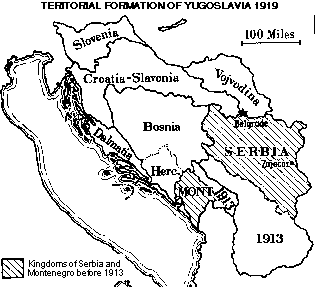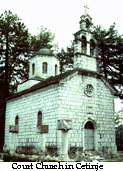Montenegro

 In
view of the dominant place of the Serb-Croat conflict in Yugoslav politics,
almost no attention has been given by historians to the development of
Montenegro between the world wars. Economic development, including foreign
investment, followed the lines of political patronage-and therefore little
of it filtered into Montenegro. No new rail building took place, no new
mineral extraction was initiated, and there was little road construction.
Having few large estates to expropriate, it was almost untouched by agrarian
reform. Port development in the Gulf of Kotor was largely confined to military
facilities; similarly, in the words of one historian, Bar in 1938 was "of
very little importance".
In
view of the dominant place of the Serb-Croat conflict in Yugoslav politics,
almost no attention has been given by historians to the development of
Montenegro between the world wars. Economic development, including foreign
investment, followed the lines of political patronage-and therefore little
of it filtered into Montenegro. No new rail building took place, no new
mineral extraction was initiated, and there was little road construction.
Having few large estates to expropriate, it was almost untouched by agrarian
reform. Port development in the Gulf of Kotor was largely confined to military
facilities; similarly, in the words of one historian, Bar in 1938 was "of
very little importance".
 By
almost all indicators of economic well-being, the Zetska banovina (a governorship
in interwar Yugoslavia that roughly corresponded to Montenegro) vied for
the lowest place with the banovina of Vardarska (comprising parts of Macedonia).
Montenegro's most important export in this period was probably emigrants.
By
almost all indicators of economic well-being, the Zetska banovina (a governorship
in interwar Yugoslavia that roughly corresponded to Montenegro) vied for
the lowest place with the banovina of Vardarska (comprising parts of Macedonia).
Montenegro's most important export in this period was probably emigrants.
Any dissatisfaction that this neglect may have occasioned on the part of Montenegrins is hard to gauge, given the centralization of Yugoslav politics and the proscription of free party organization under the royal dictatorship after 1929. It is perhaps indicative, however, that the Communist Party thrived as much in marginalized areas such as Montenegro as it did in such large industrial centers as Zagreb and Belgrade.
When Yugoslavia was invaded and partitioned by the Axis powers in April 1941, Montenegro was appropriated by the Italians under a nominally autonomous administration. Within a few months spontaneous armed resistance began. This was divided in its aims and loyalties between communists and their sympathizers and noncommunist bjelasi (advocates of union with Serbia). At the same time, some Montenegrin nationalists (zelenasi), disappointed by the experience of unification, supported the Italian administration. This local conflict was soon entangled within the wider Yugoslav struggle. The local strength of the party gave the communists an effective base in Montenegro. In addition, the area's remoteness and difficult terrain made it an important refuge for Tito's Partisan forces during the most difficult stage of their struggle, and it became a relatively safe haven after the fall of Italy.
The Montenegrins' traditional Pan-Slavism and inherited bravery made them natural allies with the communist project of the reunification of Yugoslavia. Consequently, after the war many Montenegrins found themselves in high positions within the military, political, and economic administration-in contrast to their former marginality. This same devotion to the party and to Soviet leadership, as well as to the Pan-Slav ideal, was in part responsible for the large number of Montenegrins who sided with Stalin in the dispute between the Cominform and the Yugoslav leadership. These people paid for their loyalty in subsequent purges particularly in 1948 following the notorious 'Resolution of Inforbiro'.
The communist strategy of attempting to unify Yugoslavia through a federal structure elevated Montenegro to the status of a republic, thus securing Montenegrin loyalty to the federation. Montenegro became a regular recipient of large quantities of federal aid, which enabled it to embark for the first time upon a process of industrialization. In spite of an attempt to develop the Niksic area as a center of both bauxite mining and steel production, economic progress was constantly hampered by the republic's marginality to the communication networks of the federation. It was not until the 1980s that the Montenegrin coast emerged as an important tourist area.
 The
breakup of the Yugoslav federation after 1989 left Montenegro in an acutely
precarious position. The first multiparty elections in 1990 returned the
reformed League of Communists to power, confirming Montenegrin support
for the disintegrating federation. The Republic therefore joined Serbia
efforts to preserve the Federation and in 1992 it acceded to the "Third
Yugoslavia," a federal republic comprising only it and Serbia. On the other
hand, in 1989 the remains of King Nicholas and other members of the former
royal family were returned to Montenegro to be reentered with great ceremony
in Cetinje. This sign of the continuing strength of a sense of distinctive
Montenegrin identity was matched by lively criticism of the conduct of
the war in Bosnia and Herzegovina. In addition, United Nations economic
sanctions against Yugoslavia (1992) damaged Montenegro seriously, especially
by undermining its lucrative tourist trade.
The
breakup of the Yugoslav federation after 1989 left Montenegro in an acutely
precarious position. The first multiparty elections in 1990 returned the
reformed League of Communists to power, confirming Montenegrin support
for the disintegrating federation. The Republic therefore joined Serbia
efforts to preserve the Federation and in 1992 it acceded to the "Third
Yugoslavia," a federal republic comprising only it and Serbia. On the other
hand, in 1989 the remains of King Nicholas and other members of the former
royal family were returned to Montenegro to be reentered with great ceremony
in Cetinje. This sign of the continuing strength of a sense of distinctive
Montenegrin identity was matched by lively criticism of the conduct of
the war in Bosnia and Herzegovina. In addition, United Nations economic
sanctions against Yugoslavia (1992) damaged Montenegro seriously, especially
by undermining its lucrative tourist trade.
